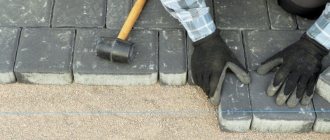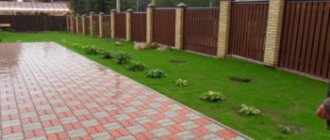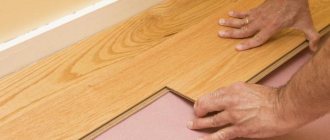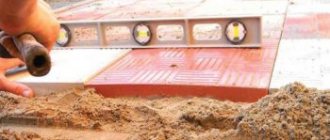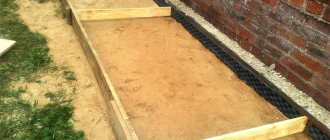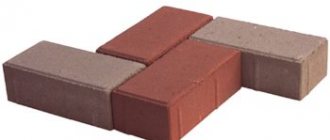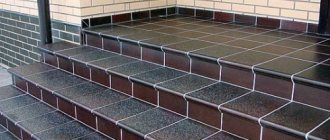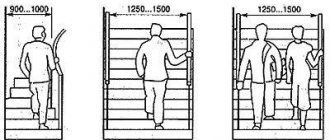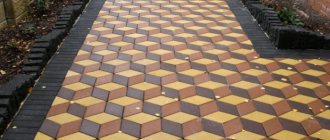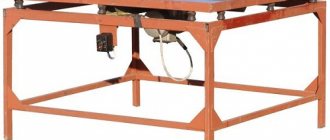Currently, work is underway to adapt blind people to independently safely move through the streets and in various buildings of populated areas.
The main component of the process is the placement of tactile tiles in places that may pose a danger to the health and life of visually impaired people.
Tactile tile catalog
from 110 rubles
Material: Concrete Dimensions: 300*300*50 Reef: Diagonal Tactile reef height: 5mm
from 110 rubles
Material: Concrete Dimensions: 300*300*50 Reef: Longitudinal Tactile reef height: 5mm
from 110 rubles
Material: Concrete Dimensions: 300*300*50 Reef: Cone-shaped Tactile reef height: 5mm
from 110 rubles
Material: Concrete Dimensions: 300*300*50 Reef: Cone-shaped Tactile reef height: 5mm
Rules for installing tactile tiles
Instead of creating a single accessibility project for visually impaired people for an entire street, square, or park, the city administration obliges entrepreneurs to install tactile tiles (or apply three-dimensional elements to an existing surface) in front of their facility themselves.
This is being done not only piecemeal, but also incorrectly. As a result, instead of facilitating the movement of visually impaired people in the city, obstacles are created for everyone else. Tactile tiles have not yet been noticed inside administrative buildings. Let's give examples of how this is done on the streets of Sochi.
The most common mistake is placing the tactile tiles not across the entire width of the obstacle.
st. Vorovsky
st. Parkovaya.
Confectionery "Biscuit" on Primorskaya embankment.
Before the pedestrian crossing on the street. Ostrovsky. Moreover, the tiles used here are not the ones required by GOST
Some shopping complexes approach the problem more systematically, but with errors.
Shopping center "White Swan" on the street. Moscow. The staircase is not marked along all widths and it is not clear why there is a double movement guide.
Shopping center "Odyssey" on Platanovaya Alley. The tactile surface starts in the middle and only one direction of movement is taken into account.
In its most monstrous form, tactile tiles were used in the improvement of the Adler Ring.
© bescker.ru
Meanwhile, special rules for installing tactile tiles have been developed depending on the location, which are set out in GOST R 52875-2007 “Ground-based tactile signs for the visually impaired. Technical requirements" .
Unfortunately, Russian manufacturers sell only three types of tactile tiles, instead of the four prescribed in GOST. The sizes are also different for all manufacturers and most often are far from the standard.
The state standard separates the requirements for tactile road signs used on the street and tactile floor signs used in buildings.
Purpose, dimensions, corrugation shape and location of tactile road signs
What are the features of granite slabs?
Tactile tiles, which are made from granite, have their undeniable advantages over other materials. Among its main indicators is a very long service life. It also does not deteriorate under the influence of the environment and its appearance does not change at all, although a huge number of people will pass through it every day.
Paving slabs made from granite are distinguished by a large number of color schemes. These tiles combine well with any surface or asphalt, and they will not require any additional care after laying them.
According to most customers, tiles made from granite are very expensive, and not everyone can afford them. But there are some nuances here. The cost of a granite slab will depend on how rare the material is mined.
Although expensive, it is very necessary for disabled people
Companies that produce granite slabs find the most advantageous location based on geographic location, and this will determine the quality and uniqueness of the granite. Tactile tiles made from deposits in the Urals have a very affordable price.
Tactile plates are divided into two options depending on where they are planned to be used:
- Road slabs - used in front of pedestrian crossings on the street
- Floor slabs - are used only indoors, for example, in metro stations or shopping centers
At enterprises that manufacture slabs, it is usually possible to order paving slabs not only with standard patterns: square or rectangle, but also with an individual pattern. The price for such plates is discussed separately.
Standards and rules for laying tactile tiles on sidewalks for the blind
One of the main criteria for the accessibility of street space for people with limited mobility is adapted ways for people to move – sidewalks and pedestrian crossings.
According to SP 59.13330.2016 “Accessibility of buildings and structures for people with limited mobility,” the width of the pedestrian path should be at least 2 meters, while the longitudinal slope should not exceed 5%, and the transverse slope should not exceed 2%. These requirements are in place to ensure that a person in a wheelchair can move along the sidewalk without using unnecessary physical effort and without interfering with other pedestrians moving in the same and oncoming directions. For blind and visually impaired people, travel routes and obstacles on the route (flower beds, trees, protruding elements of buildings, changes in direction of movement, pedestrian crossing) should be marked with tactile tiles. At the same time, according to GOST R 52875-201 “Technical aids for blind and visually impaired people. Tactile signs on the pedestrian surface”, the base of the tile should be flush with the surface of the sidewalk, and the height of the tactile elements should not exceed 5 mm. According to the principle of universal design: so that the creation of safe travel conditions for some categories of citizens does not become an insurmountable obstacle for others.
To create the right project, you need a well-prepared technical specification.
The current legislation imposes the following requirements on pedestrian crossings. According to clause 5.1.5 of SP 59.13330.2016, curb ramps with a width of at least 1.5 m and with a slope of no more than 5% that do not protrude onto the roadway must be installed at the crossing of the roadway. In this case, the height difference should not exceed 1.5 cm. If the pedestrian crossing is adjustable, the traffic light should be equipped with an audible beacon that duplicates the permitting or prohibiting signal.
Tactile tiles are the main street tactile ground sign designed to guide people with physical vision impairments on the street. Also, an additional means of adaptation for MGN are tactile stickers on handrails, tactile pictograms and light beacons. All signs are placed in accordance with GOST R 51671-2000.
Due to the introduction of the new set of rules SP 59.13330.2016, the adaptation scheme may not comply with the standards. The current version is currently under development. We apologize for the inconvenience caused!
What GOST requirements must a tactile plate meet?
The entire slab, without exception, must be manufactured only in accordance with the rules of GOST, clause 4.1.2 of GOST R 52875-2007:
- The entire plane of the slab should be wavy
- It must have anti-slip properties and a surface with roughness.
- It is correspondingly different in color from the asphalt that is laid next to it. This is done so that people with low vision can see it well.
In order for a slab to have the same value everywhere, it must meet the same rules:
- Underground passage - here the width of the paving slab must be 500 mm, the image must be cone-shaped
- Ground passage – slab width 500 mm, openings have an enfilade shape
- Ground passage under 900 - two sections, each 500 mm wide, their holes must be diagonal
- Directional paths – width not less than 500 mm, enfilade reefs
- Turn on the right side or on the left side - a square plate of at least 500 mm, diagonal holes
- Traffic light - square configuration of the paving slab, at least 500 mm, reefs have a square shape
- Obstacle - such a place must be at least 500 mm, the holes are square
These tiles are indispensable in the subway.
How to lay tactile tiles: rules
A person who is inexperienced in laying tactile tiles believes that it is enough to lay several tile elements on the floor or on asphalt, and the problems of visually impaired people will be solved. In reality, there are requirements for installing tactile tiles that must be met.
Today there are three types of tiles according to the designs on them. This:
- longitudinal reefs;
- square reefs;
- reefs are diagonal.
Each drawing has its own purpose. When installing tactile tiles, you need to take into account that square (or conical) reefs indicate an obstacle ahead. Longitudinal reefs direct forward, diagonal reefs indicate a turn. Accordingly, the rules for laying tactile tiles include a reflection of these purposes.
Thus, tiles with a square pattern are installed directly in front of any obstacle. Cone reefs exist to tell the visually impaired that this is the last step of the staircase. In addition, such steps are always painted in bright colors.
Where is it used?
Tactile boards are used in public buildings, on sidewalks, in front of pedestrian and underground passages, and entrance doors. Depending on the installation location, there are:
- road,
- floor
Placements
Tactile tiles can be installed both at home and in public places, but always according to the following rules.
- A tactile strip is placed in front of the steps to indicate an obstacle. The same tape is installed on the side of the shower stall or bathtub.
- On the first and last steps of the staircase, tiles with cone-shaped corrugations are placed, as well as contrasting ribbons.
- Plates with square corrugations are installed in places with obstacles (in front of traffic lights, etc.), and cone-shaped ones are installed in the subway.
- Plates with longitudinal corrugation are mounted on ground paths.
It is noteworthy that tactile tiles are made predominantly in bright yellow, since this is the shade that is recognized by visually impaired people.
You can learn about tactile tiles and their installation from this video:
Prices for installation of tactile tiles
Many organizers of tactile elements are interested in how much such installation will cost. The estimate for installing tactile indicators includes:
- cost of tiles in terms of square meters;
- the material from which the tiles are made;
- assessment of installers' work.
It cannot be said that installing tactile tiles on the sidewalk differs greatly in price from similar work in a building. To know exactly the price of laying tactile tiles, you should first talk to specialists. You can carry out this work yourself, however, not everyone knows the schemes for laying tactile tiles in a given situation, so it will be easier to entrust such actions to professionals.
Depending on where the tiles are laid, different quantities will be required. Thus, on an adjustable pedestrian crossing, laying tactile tiles for disabled people will require more material than on an unregulated one. In addition, specialists perfectly know the technology of laying tactile tiles for the disabled and will not make mistakes during installation. Therefore, it is better to trust them than to lay tiles at your own risk without special knowledge, saving money.
Rating of outdoor use of tactile tiles (diagram)
We hope that our site helped you make the right choice!
The first place among the types of tactile tiles used on the street by a large margin is occupied by concrete tiles. It has the highest strength characteristics, as well as the lowest price. These two factors are attractive to the buyer. At the same time, concrete tiles have one significant drawback - they are installed only by dismantling the surface.
In second place as tactile tiles used outdoors are TPU tiles. It is universal for both indoors and outdoors. As we said earlier, its only drawback is its high cost. At the same time, significantly more polyurethane slabs will be required for the street.
Surprisingly, the third place goes to PVC tiles. It is actively used in the southern regions, where there are no severe frosts and little precipitation.
Next comes metal tiles. Large commercial companies use stainless steel tiles at entrances so as not to spoil the façade of the building.
On the fifth line is a not very popular type of tactile indicators that came to us from Europe - cold plastic. This material has gained particular popularity as road markings. However, when used as tactile indicators, over time the cold plastic falls off and loses its shape.
The main share of tactile tiles in premises is PVC tiles. It is easy to install, has good wear resistance, and is also cheaper than many analogues. PU tiles deservedly take second place. Moreover, in terms of strength characteristics, it is more resistant than PVC. It is thanks to its performance qualities, including resistance to temperature changes, that it can also be laid outdoors. It loses to PVC tiles only in price, which is why it comes in second place.
The third place of honor is occupied by metal tiles. Possessing high strength characteristics and, most importantly, an aesthetic appearance, it is widely used in commercial companies. Next, with a small gap, comes ceramics. It is often used in social and public places with high traffic: airports and train stations. Being inexpensive, this tile does not have a strong contrast. Moreover, the color of the tiles fades over time. The remaining types of tactile tiles are not used as often due to their lower performance properties.
As a result of the development of the federal program “Accessible Environment”, the number of adapted facilities for people with disabilities is increasing every year. Moreover, the growth dynamics of barrier-free spaces are projected until 2020.
INSTALLATION OF TACTILE TILES
You can read how tactile tiles for disabled people are laid (installed) in the manual that we have prepared especially for you. Instructions for installing tactile tiles
First, let's define the purpose:
TYPE 3 RIFLES WITH DIAGONAL REEFS
Accommodation . Across the walkway (perpendicular) on both sides in front of a line of slabs with longitudinal reefs.
Drawing of tactile paving slabs with diagonal reefs.
TYPE 2 RIFLE WITH LONGITUDINAL REEFS
To indicate the direction of travel straight ahead
Accommodation . Parallel along the edge of the roadway in a strip 500 - 600 mm wide or perpendicular to the edge of the roadway, parallel to the transition along its entire width with a distance from the edge of no less than 600 and no more than 800 mm.
Drawing of tactile paving slabs with straight reefs.
TYPE 1 RIFLE WITH CONE REEFS
Tiles to warn persons with disabilities (disabled people): Attention, underground passage. Attention, the step before the crossing and Attention, the danger of entering the lane intended for transport (cars or trains)
Accommodation.
Along the edge (parallel) of the first step of a staircase, the beginning of a passage or roadway, with a strip 500 - 600 mm wide, equal to the width of the transition section at a distance of at least 600, but not more than 800 mm from the edge of the step, ground or underground passage, platform or other roadway parts (further, at the total distance from the edge of the dangerous area and the width of the strip of mounted cone-shaped tiles, tiles of type 1 and type 2 should be installed according to the rules described above)
Drawing of tactile paving slabs with cone reefs for the disabled.
TYPE 4 RIFLE WITH SQUARE REEFS
Warning tile for a traffic light mast, road sign or lamp post.
Accommodation .
Attention, the obstacle is mounted in the form of a square, laid out around the traffic light mast (the mast should be in the center of the intersection of the joining seams of four tiles laid in a large square), or should be laid out along the contour or along another obstacle.
Drawing of tactile paving slabs with square reefs
Extract from GOST R 56305-2014 “Tactile signs for the visually impaired.” Tactile paving slabs with conical (TPT-3) or square (TPT-4) reefs are intended for laying directly near underground and overground passages, laying near various obstacles (for example: poles, exits from garages) and at railway stations.
Guided tactile paving slabs with longitudinal and diagonal reefs for the disabled are designed for pedestrians with reduced vision, so that they can move freely around the city.
Installation and installation of tactile tiles requires the laying company to have the ability to work with large-area concrete products (for tactile tiles measuring 500x500, the area to be laid is 1/4 of one square meter).
It is also necessary to take into account that tactile tiles were invented to help people with disabilities, and not to distract them from the already difficult situation on the roads. For this purpose, multidirectional reefs were invented, such as:
— guides (straight-reefs and diagonal-rotary reefs),
— warning of danger (cone or square reefs).
Following simple logic, a tactile tile guiding the crossing should be placed in front of the pedestrian crossing, and a tile with cone reefs should be placed immediately before the exit to the roadway. Unfortunately, many companies do not take this simple truth into account and lay tactile tiles either parallel to the transition, or use them for decorative purposes, confusing people with disabilities.
Laying technology
There are 2 methods of laying tactile road surfaces - on a sand cushion and on a cement screed. Installation on a sand cushion helps remove moisture from the surface and allows you to replace elements damaged during operation.
The soil is removed to a depth of 20 cm, a backfill of crushed stone is made, then a layer of sand up to 7 cm is poured, the layers are carefully compacted. After compaction, a final layer of sand up to 2 cm is applied on which the tiles are laid, tapped for compaction with a rubber hammer, then leveled using a building level.
Installation of polyurethane products is carried out using a two-component adhesive recommended by the manufacturer on a previously cleaned surface. The manufacturer's specifications and recommendations must be observed.
Warning tactile elements should be placed perpendicular to the dangerous area along its entire length in a continuous strip 500 - 600 mm wide.
Textile guide tiles are laid out along the entire area of movement of the disabled person. Longitudinal corrugated strips are directed parallel to the sidewalk. In places where sidewalks turn or cross, tiles with diagonal stripes directed in the direction of the turn are installed.
Tactile signs are made of non-slip materials in bright contrasting colors. Executive authorities and the society of the blind, taking into account that the sensitivity of the human eye to yellow color is maximum, recommend the use of yellow coloring.
Use tactile tiles that have been painted during production. Tiles that are painted after installation lose their color within one and a half to two years and require additional painting or replacement.
Features of laying tactile tiles.
There are two ways to lay tactile tiles:
1) for concrete mortar;
2) for a mixture of crushed stone and sand.
Using a concrete mixture when constructing sidewalks is not the best solution, because... Installation time increases and the dismantling process becomes more complicated. The base of the mixture is sand, which is then used to cover the crushed stone. Tactile tiles are laid exactly end to end. It is very important that when laying tactile tiles everything is smooth and neat. In addition, it is necessary to make a slope for water drainage. Also, when laying tactile tiles, a curb must be provided at the edge of the sidewalk.
Specifications
The main technical indicators of concrete TUPP are:
- Geometric dimensions (excluding protruding tactile elements): length/width/thickness. GOST provides two standard sizes for this category of concrete products: 300×300×30 and 500×500×50 mm.
- Height of reefs protruding above a smooth surface (for both warning and TUPP guides): 4 mm – for rooms with exceptionally smooth floor surfaces; 5 mm – for other indoor coatings; 7 mm – for external use.
Basic principles for installing tactile signs
In order for tactile concrete tiles to “convey” the necessary information to a visually impaired person, it must be laid in compliance with the rules set out in GOST. For example, a warning sign must have a minimum size of 500 x 500 mm. Moreover, an irresistible source of danger (for example, a road sign or billboard) must be surrounded by tactile elements along the entire perimeter with a distance of 300 mm from the obstacle itself. Research has shown that it is precisely this arrangement of the TUPP that allows a blind pedestrian to slow down the pace of movement and make an adequate decision to safely bypass the obstacle.
The effective width (i.e. the distance between the outer ridges of the tactile elements) of the directional indicators (to indicate the path of movement) must be at least 250 mm. The dimensions of the turning zone, for the arrangement of which tiles with parallel ridges located at an angle of 45ᵒ to the direction of movement are used, must be at least 500 × 500 mm.
Important! If tactile elements are laid on a pedestrian surface without following strict rules, this leads to misinformation for visually impaired people and only complicates their safe movement in space, as evidenced by the video below.
Why is it worth buying tactile tiles from Art-Kamen LLC?
Our price and quality of tactile tiles for the disabled, manufactured in strict compliance with GOST R 56305-2014 and strict control of purchased materials, allowed our company to become a leader in its production!
We produce our tactile tiles at our own production site, located on the small Concrete ring of the Moscow region! Delivery of tactile tiles to any region of the Russian Federation : delivery geography from Kaliningrad to Irkutsk, and from St. Petersburg to Sochi!
Tactile tiles GOST R 56305-2014 instead of GOST 52875-2007 are presented in Moscow, which specializes in the production and sale of these products.
The tile is easy to handle and shows the direction of movement. This new product appeared relatively recently, but has already won the hearts of people with disabilities - thanks to this development, visually impaired people began not only to calmly navigate space, but also to find the right places.
Tactile tiles for disabled people are manufactured in accordance with GOST R 56305-2014 (replacing GOST No. 52875-2007) and installed at various significant facilities in Moscow. In the production of tiles, materials are used that undergo strict quality control.
Thanks to this new product, people with disabilities no longer feel constrained when moving - they can now move from one end of the city to the other with complete ease.
The advantages and quality of tactile tiles from ART-STONE gave us the opportunity to receive a city order for its installation in all public places.
Concrete tactile tiles, the price of which does not differ from the populated areas of our vast homeland. You can view the price list of tactile tiles in a specialized section or by asking the company’s specialists.
Tiles can be purchased in any volume in the shortest possible time.
Buying tactile tiles is quite easy and simple. To do this, you need to place an order by phone or fill out a specialized form on the website, after which a manager will contact the client in the shortest possible time and clarify the necessary order details.
From the moment the tile was GOST-certified and produced at our enterprise, it won more than one city competition - we made people with disabilities feel freer.
Manufacturing methods and materials used
In factory conditions, two methods are used to produce concrete tactile tiles:
- Vibration pressing.
- Vibrocasting.
In both cases, a solution based on high-strength cement (grade M500), sifted sand, special synthetic polymer additives, dye and fine granite gravel is used as a building material. To increase the strength characteristics, polypropylene fiber is added as reinforcing elements to the composition for the manufacture of tactile tiles.
Types and features
Tactile tile products have the same appearance as standard tiles. However, it contains on its surface a relief pattern of a cone-shaped or linear shape.
Using a stick, a blind person can easily determine the direction of the stripes. For example, if they are across, it means you need to turn left or right, and straight lines allow passage. Cone-shaped symbols (reefs) serve as a warning that there is a dangerous area along the way (car route, descent or ascent).
There are 4 types of corrugation:
- longitudinal - shows the direction in which you need to move;
- square - indicates an obstacle on the way;
- diagonal - indicates the need to make a turn;
- cone-shaped - means there are steps ahead.
Tactile paving slabs
The presence of a tactile surface on sidewalks helps blind people with disabilities move more freely along the street. Laying corrugated tiles on the streets of populated areas is still not widespread, but this situation is gradually changing. In equipped pedestrian areas, blind people feel much more confident and can move around without fear of accidentally walking onto the roadway or falling down the stairs.
Tactile paving slabs have long been used in many well-equipped rehabilitation, sanatorium and medical institutions where disabled people are treated and restored. There, the installation of such coverings is used as information strips indicating the direction of movement.
Blind paving tiles are made in the same way as regular paving materials, but the surface has small spherical, conical or linear projections that rise above the main plane. They can be easily felt with a stick, thereby obtaining information about the desired direction of movement.
Longitudinal lines indicate that the path is open, and a transverse arrangement means a turn to the right or left. But spherical or conical protrusions indicate approaching a dangerous zone.
To ensure that people with normal vision do not occupy the passage provided for the disabled, tactile slabs are made colored and different from the rest of the sidewalk covering. A bright stripe attracts the attention of other pedestrians, concentrates it on the moving blind person and offers to give way.
Production technology
Tactile type tiles have a square shape and are most often produced using semi-dry vibration pressing technology.
The raw materials for the manufacture of this material contain only safe and natural ingredients: fine crushed stone, purified water, sand particles, slag and cement. The components provide the finished product with a high level of reliability, durability and environmental friendliness.
In addition, the tactile material is frost-resistant and is not afraid of prolonged exposure to ultraviolet radiation.
Such tile products can easily withstand heavy use and temperature changes. The tiled surface provides an anti-slip effect and does not accumulate moisture, preventing pedestrians from getting wet and falling.
Tactile tiles are not afraid of the influence of chemicals and can easily withstand even significant mechanical stress.
In addition, this material is convenient to install.
Advantages and disadvantages of concrete tactile tiles
The main advantages of the tactile variety of tiles:
- affordability;
- ease of installation;
- long service life;
- environmental friendliness;
- safety for the body;
- small sizes;
- high level of strength;
- wide choice of configurations and shapes;
- water permeability;
- Possibility of assembly/disassembly.
Among the shortcomings, experts highlight the following:
- surface slipping in winter;
- frequent mismatch of joints in which debris and dirt can accumulate;
- risk of subsidence;
- The porous structure of the coating causes the moisture accumulated in it to freeze in the cold.
Criterias of choice
The choice of material for installing tactile pavement is made taking into account the architectural features and design of installation sites, the availability of existing paving surfaces, the financial budget and the planned corrugation characteristics.
To lay this type of coating, a special project is first developed, which indicates the type and direction of corrugation in accordance with the road situation, as well as the required volume of materials. Then the following criteria are taken into account:
- appearance;
- resistance to external influences;
- strength;
- price.
Laying process
The peculiarity of laying tactile type tiles is the correct placement of protrusions and slab patterns. This will determine the information content of the material and the possibility of its use by visually impaired and blind people.
On urban pedestrian paths, the width of the corrugated strip should be at least 100-150 cm. In this case, the location of the convex lines should be selected in accordance with the traffic conditions in this area.
A dot pattern means the end of a path or approaching a potentially dangerous area (highway, descent, ascent, etc.).
A continuous 50-centimeter strip is used to mark underground passages. The pedestrian path area passing through the road is laid out in a similar way. The edge of the roadway is marked with an additional strip. This is necessary so that the disabled person has the opportunity to find out that he has crossed the road.
Before laying tactile tiles, you need to create a schematic sketch or drawing, which will indicate all the nuances that need to be taken into account. This will allow you to avoid mistakes and calculate the required amount of material.
Bases for laying
To lay this type of tile covering, you can use the same base as for laying standard tiles. Paths and sidewalks are constructed after removing a 20-25 cm soil layer. The surface of the bottom of the dug hole must be thoroughly compacted and covered with geotextile. This material will prevent moisture from penetrating from below and weed growth.
Crushed stone, gravel-sand mixture and gravel are poured onto the geotextile. The thickness of this layer should be at least 15-20 cm. After this, the surface is compacted. The pillow is made from a 5-7 cm layer of a mixture of cement and dry sand in a 5:1 ratio. It is compacted during paving by tapping the tiles with a rubber hammer.
The tile joints are filled with a sand-cement mixture and filled with water. Then the procedure must be repeated. This will ensure maximum tightness of the coating and prevent moisture from entering the base.
Review of types of tactile tiles, video installation instructions
The main task of the federal program “Accessible Environment” is to adapt important objects and buildings for all people with disabilities (hospital, post office, educational institution, cultural and sports institutions, park, bus stop, etc.). One of these areas is the installation of ground-based tactile signs along the paths of people with visual impairments. They help blind and visually impaired people adapt to the urban environment.

